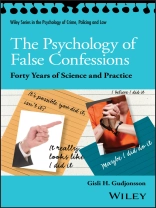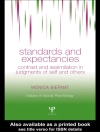Provides a comprehensive and up-to-date review of the development of the science behind the psychology of false confessions
Four decades ago, little was known or understood about false confessions and the reasons behind them. So much has changed since then due in part to the diligent work done by Gisli H. Gudjonsson. This eye-opening book by the Icelandic/British clinical forensic psychologist, who in the mid 1970s had worked as detective in Reykjavik, offers a complete and current analysis of how the study of the psychology of false confessions came about, including the relevant theories and empirical/experimental evidence base. It also provides a reflective review of the gradual development of the science and how it can be applied to real life cases.
Based on Gudjonsson’s personal account of the biggest murder investigations in Iceland’s history, as well as other landmark cases, The Psychology of False Confessions: Forty Years of Science and Practice takes readers inside the minds of those who sit on both sides of the interrogation table to examine why confessions to crimes occur even when the confessor is innocent. Presented in three parts, the book covers how the science of studying false confessions emerged and grew to become a regular field of practice. It then goes deep into the investigation of the mid-1970s assumed murders of two men in Iceland and the people held responsible for them. It finishes with an in-depth psychological analysis of the confessions of the six people convicted.
- Written by an expert extensively involved in the development of the science and its application to real life cases
- Covers the most sensational murder cases in Iceland’s history
- Deep analysis of the ‘Reykjavik Confessions’ adds crucial evidence to understanding how and why coerced-internalized false confessions occur, and their detrimental and lasting effects on memory
The Psychology of False Confessions: Forty Years of Science and Practice is an important source book for students, academics, criminologists, and clinical, forensic, and social psychologists and psychiatrists.
Daftar Isi
About the Author xv
Series Preface xvii
Preface xxi
Acknowledgements xxv
Icelandic Names xxvii
Introduction 1
A Brief Review of my Cases on Disputed Confessions (1980–2016) 3
The Structure and Content of the Book 4
The Gudmundur and Geirfinnur Cases 6
Part I: The Emerging Science and Practice 9
1 An Era of Enquiry and Development 11
My Early Research on Lie Detection 13
The Sunday Times Experiment 18
British Psychological Society Committees on Lie Detection 20
Onward and Upward 22
Conclusions 24
2 The Impact of Real‐Life Cases on Legal Changes, Police Practice, and Science 27
The Confait Case 28
The Guildford Four 31
The Birmingham Six 35
The Tottenham Three (Engin Raghip) 37
The Case of Judith Ward 38
The Cardiff Three (Stephen Miller) 39
The PEACE Model of Interviewing 45
Summary and Conclusions 48
3 Interrogative Suggestibility 51
The Experimental Approach 52
The Individual Differences Approach 54
The Gudjonsson and Clark Model 59
Conclusions 61
4 The Psychology of False Confessions: The Theories 63
Definitions of False Confession 64
An Early Conceptual Framework 64
The Kassin and Wrightsman Threefold Classification 66
Critique of the Kassin–Wrightsman Classification 68
Key Components That Elicit and Facilitate the Internalization Process 73
Memory Distrust Syndrome 74
The Five Sequential Steps 77
Immediate Versus Delayed Suggestibility 81
A Heuristic Model of Internalized False Confessions 82
Conclusions 85
5 The Development of the Science: The Evidence Base 87
Brief Summary of Theoretical Developments 88
Landmark Early Studies on Police Interrogation 97
False Confessions in Miscarriages of Justice Research 99
Rate of Interrogation, Base Rate of Guilt, and False Confessions 103
Type of Offence Falsely Confessed To 108
Reasons Given for the False Confession 110
‘I’d Know a False Confession if I Saw One’ 113
Risk Factors 114
Situational Risk Factors 117
Personal Risk Factors 124
The Psychological Effects of Interrogation 134
Conclusions 134
Part II: The Gudmundur and Geirfinnur Cases 139
6 Icelandic Society in the 1970s 141
Brief History and Landscape 141
The Constitution and Government 144
The Police 145
The Courts 148
Prisons 149
Drug Abuse Problems and Smuggling 150
Media Frenzy 152
Homicide in Iceland 153
Conclusions 157
7 The Keflavík Investigation and the First Confession 159
The Investigation and Principal Characters 160
The Disappearance of Geirfinnur Einarsson 162
The Keflavík Investigation Into Geirfinnur’s Disappearance 163
The First Confession to Geirfinnur’s Disappearance 170
Conclusions 174
8 The Confessions in the Gudmundur Einarsson Case 177
The Post and Telecommunication Fraud 178
The Disappearance of Gudmundur Einarsson 182
The Gudmundur Einarsson Investigation 184
The Confessions to Gudmundur Einarsson’s Murder 186
Thematic Analysis of the Successive Accounts 205
The Supreme Court’s Version of the Facts in the Gudmundur Einarsson Case 208
Conclusions 208
9 The Confessions in the Geirfinnur Einarsson Case 211
The Prosecution Request for the Keflavík Papers 212
Confessions Obtained by the Reykjavík Team 217
The Reykjavík Task Force 225
Key Task Force Statements 229
Gudjón’s Arrest and Subsequent Interrogations 234
Thematic Analysis of the Successive Accounts 238
The Keflavík Slipway Re‐enactment 240
The Overlap with Gudmundur Agnarsson’s ‘False’ Confession 241
The Press Conference: The Official Version of What Happened 243
The Convictions 247
Conclusions 249
10 Misguiding Force 253
Karl Schütz’s Professional Background 254
The Spiegel Investigation 254
The Murder of Four Soldiers in Lebach 255
The Baader‐Meinhof Group 256
Appointed to the Case 258
Camera Shy 260
The Cartoons and Legal Action 261
The ‘Indian Technique’ 262
Schütz’s Foreword to his Book Kleinstadtmörder: Spur 1081 262
The Der Spiegel 1979 Article 264
Personal Impression of Karl Schütz 266
Conclusions 266
11 The Return of the Gudmundur and Geirfinnur Cases 269
Helga Arnardóttir’s Telephone Call and the Diaries 269
Meeting With Helga and Kristín 271
The Content of the Diaries 272
The Filming 276
A Call From the Minister of the Interior 276
Conclusions 277
12 The Findings From the Working Group, Special Prosecutor, and Icelandic Court Cases Review Commission 279
The Working Group 282
The General Findings of the Working Group 287
The Findings From the Psychological Evaluation 289
The Testimony in the Reykjavík District Court 291
The Findings of the Icelandic Court Cases Review Commission 298
Ragnar Adalsteinsson’s Letter to the Special Prosecutor 325
Conclusions 326
Part III: A Psychological Analysis of the Confessions of the Six Convicted Persons 329
13 Did Saevar Ciesielski Have Undiagnosed ADHD? 331
Salient Points 331
Saevar’s Interrogation 332
Retractions 333
Karl Schütz’s View of Saevar 334
Saevar’s Speech Before the District Court 335
Breidavík 335
Breidavík’s Public Enquiry 337
Yes, Saevar Did Have Undiagnosed ADHD 338
Evidence Supportive of ADHD During Childhood and Adolescence 340
The Pretrial Psychological/Psychiatric Evaluation 344
The Impact of Saevar’s ADHD on His Functioning During the Cases 345
Was Saevar Coerced to Implicate Innocent People? 347
The ‘Real‐Life’ Lie Detector Test 349
Conclusions 352
14 Erla Bolladóttir – A Vulnerable Young Woman 355
Salient Points 355
The Relationship with Saevar 358
Erla’s Interrogation 360
Erla’s Attempts to Retract Her Confessions 364
The Pretrial Psychiatric Evaluation 364
Karl Schütz’s View of Erla 366
Erla’s Interview for the Working Group 367
Models of Erla’s Confessions 368
Conclusions 371
15 Kristján Vidarsson’s Memory Distrust Syndrome and Confession 375
Salient Points 375
Kristján’s Interrogation and Confinement 376
Kristján’s Mental State in Solitary Confinement 377
Retractions 378
Karl Schütz’s View of Kristján 379
The Pretrial Evaluation 379
Kristján’s Interview for the Working Group 380
A Heuristic Model of Kristján’s Confession 381
Conclusions 383
16 Tryggvi Leifsson’s Memory Distrust Syndrome and Confession 385
Salient Points 385
History of False Confession? 386
Evidence for Memory Distrust Syndrome 387
Tryggvi’s interrogation and confession 387
Tryggvi’s Diaries 393
Did Tryggvi Have ADHD? 394
A Heuristic Model of Tryggvi’s Confession 395
Conclusions 398
An interview with Tryggvi’s widow and daughter 400
17 Gudjón Skarphédinsson’s Memory Distrust Syndrome and Confession 405
Salient Points 405
Deterioration in Mental State 406
The Arrest and Custody 407
Karl Schütz’s Perception of Gudjón 410
The ‘Lie Detection’ 410
Gudjón’s Diary 415
A Heuristic Model of Gudjón’s Confession 420
After Release From Prison 422
Conclusions 423
18 Albert Skaftason’s Memory Distrust Syndrome and Confession 425
Salient Points 425
Albert’s Interrogation 427
Memory Enhancement 428
Albert’s Account of Events, and His Personality 429
A Heuristic Model of Albert’s Confession 432
Conclusions 435
Conclusions 437
Science and Practice – The Beginning 437
The Development of the Science 439
The Gudmundur and Geirfinnur Cases 446
Lessons Learned 462
Appendix 1 465
Appendix 2 471
References 477
Author Index 499
Subject Index 505
Tentang Penulis
GISLI H. GUDJONSSON, CBE, PHD, is an Emeritus Professor of Forensic Psychology at the Institute of Psychiatry, Psychology & Neuroscience, King’s College London, and a Professor of Psychology at Reykjavik University. He is a Fellow of the British Psychological Society and a registered practitioner (clinical and forensic) with the Health Care Professions Council (HCPC).












